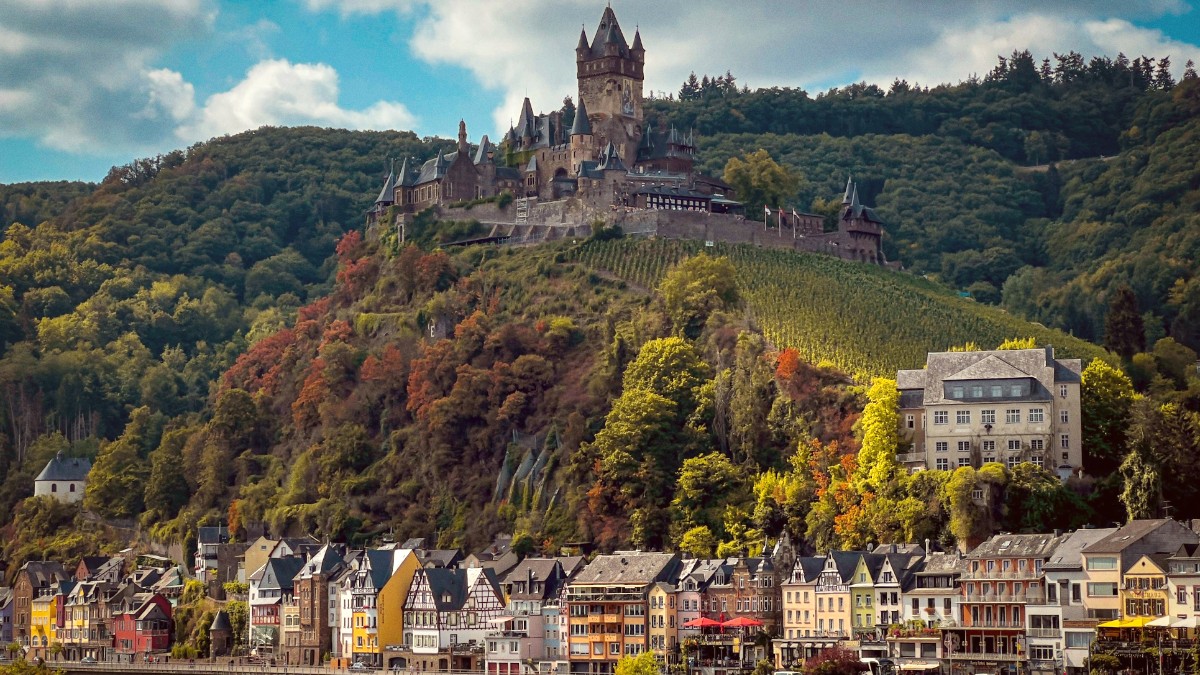
Rhineland Palatinate, Germany
Frankfurt Airport (FRA) is Germany's largest, about 1 to 1.5 hours by train from northern Rhine Valley cities. Cologne Bonn Airport (CGN) serves as another entry point, specifically for European destinations. Frankfurt-Hahn Airport (HHN) mainly serves low-cost carriers. Düsseldorf Airport (DUS) offers additional flight options.
Germany's major airports provide comprehensive facilities, including duty-free shops, restaurants, car rental services, currency exchange, ATMs, lounges, and free Wi-Fi. HHN has more limited facilities due to its smaller size.
High prices in summer (June-August) and around Christmas/New Year. Better value in shoulder seasons (April-May, September-October).
Use Dollar Flight Club or Skyscanner for comparing flight prices and finding deals.
Frankfurt Airport (FRA) boasts direct flight options from numerous major global hubs (North America, Asia, Africa, Middle East).
German roads are generally well-maintained and safe. Be aware of high speeds on Autobahns; yield to faster traffic in the left lane.
November to March means possible winter conditions (ice, snow). Winter tires are legally a condition in certain situations; rental cars are usually equipped.
Germany does not impose specific exit fees for tourists (airport taxes included in airfare). For international flights, arrive 2-3 hours before departure. Check in online to save time.
The Rhine River provides an unique and popular mode of arrival and transport within the valley. River cruises serve as a major route for scenic day trips and multi-day journeys.
Small car and passenger ferries cross the Rhine at several points (e.g., between Rüdesheim and Bingen, or St. Goar and St. Goarshausen). These aid crossing the river and accessing attractions on the opposite bank.
Plan your departure effectively to reduce stress. Ensure enough time for check-in and security processes.
Departure facilities at airports and train stations reflect those available upon arrival. They support traveler comfort before their onward journey.
Public transport in the Rhine Valley efficiently connects towns and cities, offering a reliable way to explore. The region relies on regional trains and local buses. Larger cities like Mainz, Wiesbaden, and Koblenz feature more extensive bus networks. Mainz also has trams. The regional train network (RE, RB trains, S-Bahn) forms the backbone of inter-town travel.
Germany offers a variety of ticketing options. Single tickets, Day Tickets, and Group Day Tickets are available. The Deutschlandticket is a monthly pass (€49 as of early 2024), offering unlimited travel on all local and regional public transport nationwide (excluding high-speed trains).
More frequent trains during peak hours, significantly reduced or suspended overnight.
Local buses generally operate similar hours as trains, with less frequent service on weekends and evenings.
Use the DB Navigator app for real-time schedules. Validate single tickets if required.
Taxis and ride-sharing services provide convenient, on-demand transportation. Licensed taxis in Germany are typically cream-colored or black, with a yellow "TAXI" sign on the roof.
Ride-sharing apps offer another transport option in larger cities. Safety considerations remain important for all choices.
Valid driver's license, IDP recommended for non-EU. Passport, credit card in driver's name for deposit. Minimum age 18 (21/25 for some classes).
Drive on the right. Seatbelts mandatory. Children under 12 or 150cm require child seats. Blood alcohol limit 0.05%. Roads are well-maintained.
Look for "P" signs. Blue zones require parking disc. Paid meters (Parkautomat) common. Parking garages (Parkhaus) offer secure parking.
Book your rental car in advance, specifically during peak season, to secure better rates and ensure vehicle availability. Compare prices on a site like Kayak Car Rental or DiscoverCars.com.